LED aquarium lights will likely produce the most plant growth in a planted tank and are one of the best ways to achieve that. However, a comprehensive guide is needed to help with best utilizing them.

For maximum efficiency of the selected grow lights, the beginner should be familiar with the right photosynthesis-inducing spectrum, for example.
Also, if on a budget, will cheap equipment be able to provide that for the money?
If vigorous aquarium plant growth is the goal of your planted tank then which brand of LED lights will work best for you? Is there something else you should know?
The 8 Top-Rated LED Lights for Growing Lush Aquarium Plants

| Light Name: | Planted Aquarium Depth: | Grows: | Price Bracket: |
|---|---|---|---|
| 1. Finnex Planted+ 24/7 ALC | Shallow / Medium / Deep | Medium / High-light Plants | $$$ |
| 2. Fluval Plant 3.0 | Shallow / Medium / Deep | Medium / High-light Plants | $$$$ |
| 3. Current USA Satellite Plus PRO | Medium | Medium-light Plants | $$$$$ |
| 4. NICREW SkyLED Plus | Shallow | Low-light Plants | $ |
| 5. Beamswork DA Pent | Shallow / Medium | Medium / High-light Plants | $$ |
| 6. Finnex StingRay | Shallow | Low-light Plants | $$ |
| 7. Finnex FugeRay Planted+ | Shallow / Medium / Deep | Medium / High-light Plants | $$$ |
| 8. Hygger 24/7 | Shallow | Low-light Plants | $ |
Beginner guide on LED grow lights for planted aquariums
To make an educated choice about my aquarium lighting I would first need to be familiar with how both parties function.
I suggest bookmarking this page for further reference as it’s not a small amount of information. Here’s a complete beginner guide on LED aquarium lighting for aquatic plants:
1. Don’t fall for the Kelvins myth
I often hear (and read) how other fishkeepers determine the effectiveness of their grow light by using Kelvins.
However, this measurement can be quite irrelevant for growing aquarium plants.
You’ve probably heard someone saying that the best Kelvin rating for aquatic vegetation is 6500 K.
Some claim it is even higher, reaching up to 9000 K or above.
This misconception persists because it has been known that the Sun burns at around 6000 K at noon.
Being the main source of light for all outdoor plants alike, some folks have hinted that this Kelvin range might have something to do with plant growth.
In actuality, however, this couldn’t be further away from the truth.
In layman’s terms, the Kelvin rating is the color temperature of light emitted from a light source.
Anything above 5000 K is bluish, and light with a K-rating of below 3000 K becomes yellowish.
The sun burns at nearly 5700 K, but because of our atmosphere, it gives off a white hue at noon.
However, when it comes to LED lighting, the K-rating that manufacturers state has nothing to do with the actual burning temperature.
Why you may ask?
In aquarium lighting the Kelvin ratings are based on a metric called Color Correlated Temperature (CCT).
This means that the human eye will perceive the light color from a 5800 Kelvin LED or fluorescent aquarium lighting as it would perceive the color of sunlight.
However, the fixture won’t literally burn at 5800 Kelvin.
Following these thoughts, here’s how Kelvin ratings impact aquarium plants:
The only real use of Kelvin ratings in aquarium lighting is their perceived color. Lower Kelvin ratings of 3000 and below will give off a yellow hue, medium Kelvin ratings of around 6000 will appear white and higher Kelvin ratings will be blue-ish. The Kelvin value of grow lights does not impact the growth of aquarium plants.
2. PAR readings and their role in growing freshwater plants
The range between 400 and 700 nanometers on the light spectrum chart is called Photosynthetic Active (or Available) Radiation – PAR.
This is all light that can be employed by plants for photosynthesis.
It turns out LED lights are spectacular at mimicking that.
There’s another, dare I say, equally important abbreviation that you might want to be familiar with and that’s PUR.
Photosynthetic Usable (or Utilizable) Radiation, measures the quality of light per application. PUR is unique for each aquatic plant species.
This would mean that, with everything else being equal, a LED lighting fixture with the right diodes can grow freshwater aquarium plants better than one that seems to have the same PAR output.
PUR is good to have, but PAS is where it’s at.
Photosynthetic Action Spectrum (PAS) indicates which wavelengths of light activate photosynthesis in particular.
These are the wavelengths that trigger a response in chlorophyll A and chlorophyll B (which stimulate plant growth).
PAS is considered for plant growth in particular where PUR can be related to plant health as well.
As you might’ve guessed, PAS wavelengths are also unique for each plant.
Luckily for us planted tank enthusiasts, the manufacturers of LED aquarium lighting are aware of the difference and are tweaking the formula with each new model.
The diodes on the best LED lighting fixtures will target more PUR and ideally PAS while keeping the PAR just about enough.
Here’s a video of a somewhat famous aquarist testing the PAR levels of a next-generation LED aquarium light, compared to its previous version.
The new one (Fluval Plant Spectrum 3.0) gives off less PAR than the older model, but in actuality grows freshwater aquarium plants better.
It’s a good practical example of what I’m explaining here.
Though it seems obvious, I think it’s noteworthy that the LED lights we use to grow corals require different spectrum wavelengths than freshwater aquatic plants, but that’s a topic of another article.
This brings me to my next section…
3. Pursuing the best grow light spectrum for your aquatic plants
LED lighting can be an excellent source of light for aquarium plants and provides one of the best growth for them. If the spectrum is right and the intensity – sufficient, LED lights will absolutely grow the plants in your fish tank.
Let me explain this in detail.
The electromagnetic spectrum that falls under the Photosynthetic Active Radiation contains blue, green, white, and red light, as perceived by the human eye.
You can see that in the below image:
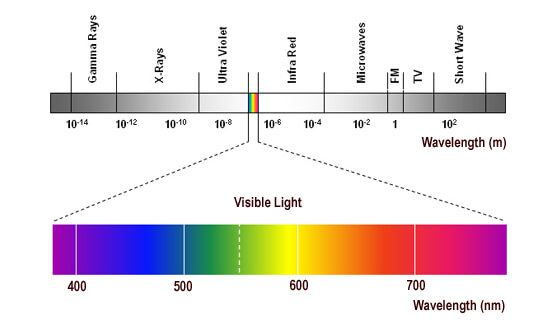
This is why sometimes you can see the “WRGB” or “RGB” label on grow lights. These stand for “white, red, green, and blue”.
Each of these light colors is essential for inducing growth in aquarium plants, with some more than others.
You can see to what efficiency each spectrum wavelength is being used by freshwater plants in the below graph:
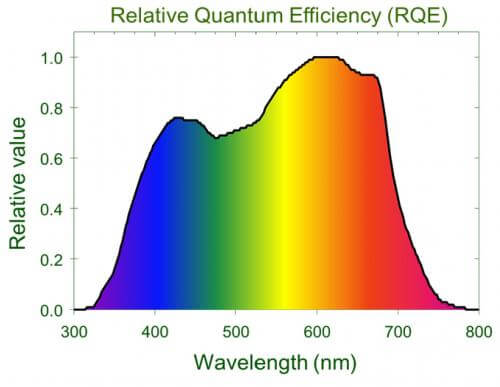
What this chart shows is that red light is used the most by plants, followed by blue.
Contrary to popular belief green light is also used, though around 30% is being reflected (hence the green color of most plants).
Because of its lower absorption rate green penetrates the plants’ leaves deeper than the other two colors.
This makes it even more valuable in deep, planted aquariums, where live plants need to make the most of the light’s energy.
Note that it’s efficiency we’re talking about here.
Blue light is high energy particles and for various reasons most of it is somewhat “lost” in the process of photosynthesis.
Note that this graph does not reflect how important the color of the spectrum is for aquarium plants, but rather how well they are able to take advantage of it for their needs.
See a photo of the experiment showing how each plant performed:
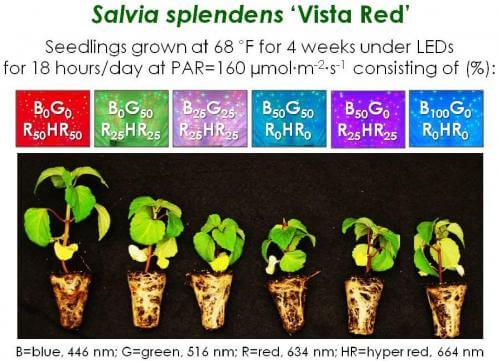
As you can see the most plant growth was achieved by combining 50% Red and 50% Hyper Red light.
Another thing that stands out is that the combination of Red and Green light performed better than anything including over 25% blue light.
However, this is not to say that blue light is not an essential part of photosynthesis.
Blue just needs to be in small quantities in order to not suppress the extension growth of live plants.
- At least 50% red light in the wavelength range of 630 to 700 nanometers
- At least 35% green light in the wavelength range of 500 to 580 nanometers
- No more than 15% blue light in the wavelength range of 435 to 495 nanometers
So…
The perfect spectrum for aquarum plant growth consists of a lot of red, some green, and just a little bit of blue. You can increase the blue for some more stem density, but overall plant mass will be maximized by the red light.
In my recommendations below I’ve taken it into account so you don’t have to.
Okay, let’s add water penetration to the equation.
4. Mind the water penetration of LED lights
Ok, so you know what the right kind of light for a planted tank should be.
For aquatic plants to thrive, however, this light needs to reach its target.
The spectrum changes with water depth.
Here’s an illustration of how wavelengths of light penetrate water:
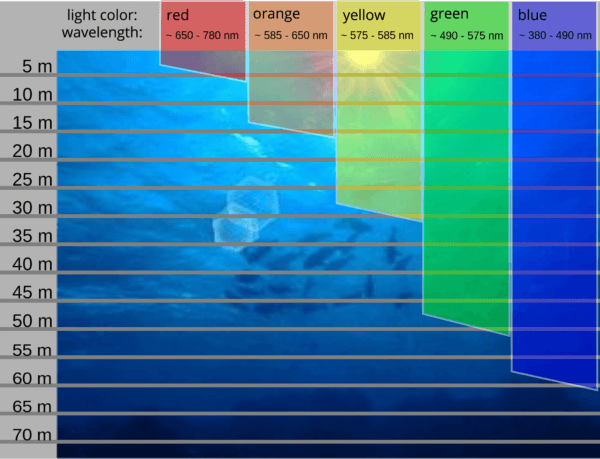
As you can see our precious red light gets absorbed pretty much on the water’s surface.
However, a planted aquarium will be nowhere near that deep.
That’s a 150-gallon fish tank.
Even at that depth, your aquarium plants will only miss out on around 7% of the incoming red light.
Green light quantities will remain pretty much stable and so will the blue spectrum.
However, as different lighting models have different spectrums, tank depth does play a pretty significant role in your choice of freshwater plants.
I’ve got that sorted out for you in my recommendation section below.
They are all based on my personal experience and observations during work with my clients, where I craft personal gear suggestions for aquarium setups.
So let’s talk about aquarium depth.
5. Tank size & depth matters
There are 2 important aspects of your planted aquarium’s size that affect the efficiency of your LED lights in regard to growing live plants:
- Tank depth (sometimes called height) – this affects water penetration of the spectrum. The lighting fixtures that I recommend will pierce the water excellently, but some will be a better choice than others for certain aquarium height in regards to optimal vegetation growth.
- Tank length – This dimension comes into play when you’re selecting the size of your fixture. There are LED grow lights with extendable brackets and ones without. The brackets only guarantee a good fit and not full light spread and coverage. Some fixtures are limited in size options, so I made sure to recommend whatever will grow your aquatic plants best, while perfectly fitting your tank’s length.
The tank’s width is not that important as the light spread of the fixtures I list below covers 24″ easily. That’s way more than your typical tank width. Only aquarium tanks with a width of over 18 inches and a depth of over 24 inches would benefit from a second lighting fixture.
You can check the numbers of most tanks available today on my resource page for tank dimensions.
6. Being flexible with customization features
Some aquarium-grade LED lights will be more flexible in terms of customization than others.
The manufacturers of the cheaper lights are obviously investing in raw performance, rather than fancy features.
The more inexpensive ones that I recommend will grow aquatic plants just fine as long as you follow my instructions and pointers.
Anyway, the more advanced aquarium LED lighting will allow for better control over the spectrum and on some occasions could even simulate weather patterns.
The weather simulations are more of a gimmick for display purposes. The spectrum customization, however, could play a role in the healthy development of plant mass.
If a timer is being included in the pack then you’ll be enjoying a really nice bonus, because it makes scheduled maintenance pretty much care-free.
7. Keep in mind your freshwater plant selection
Some freshwater aquatic plant species will require more light than others.
There are ones that can be extremely picky of the required intensity and others that will simply thrive under low lighting.
The low-demand ones are usually recommended for beginners, because of their hardiness.
Some aquarium plants that will grow under low levels of light would be:
- Brazilian Pennywort
- Java moss
- Moneywort
- Hornwort
- Guppy grass
- Anubias
- Java Fern (click this link for a beginner-friendly care sheet on that one)
- Vallisneria
…The options are too many to list here.
These are all good options to make for a heavily planted freshwater tank with diverse vegetation.
However, keep in mind that eventually (as we all do after we get hooked) you’ll want to add some more beautiful but demanding aquarium plants.
Here’s a photo of a low-tech aquarium, heavily planted with easy live plants:
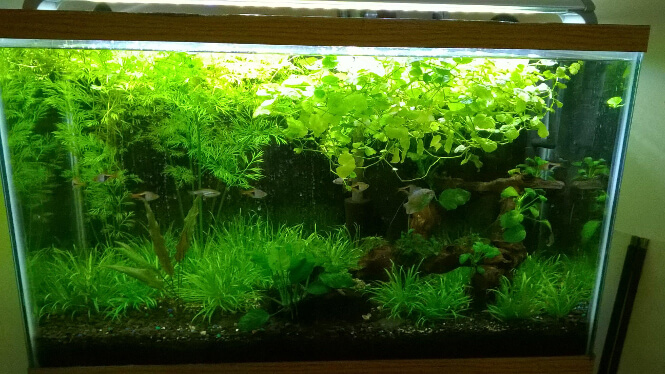
Aquatic plants used in the above setup: Pennywort, Anubias, Vesicularia montagnei (Christmas Moss), Blyxa Japonica, Crypt Wendtii, Ceratopteris thalictroides (water sprite).
And here’s a photo of a high-tech tank, planted with demanding aquarium plants, including Baby Tears:
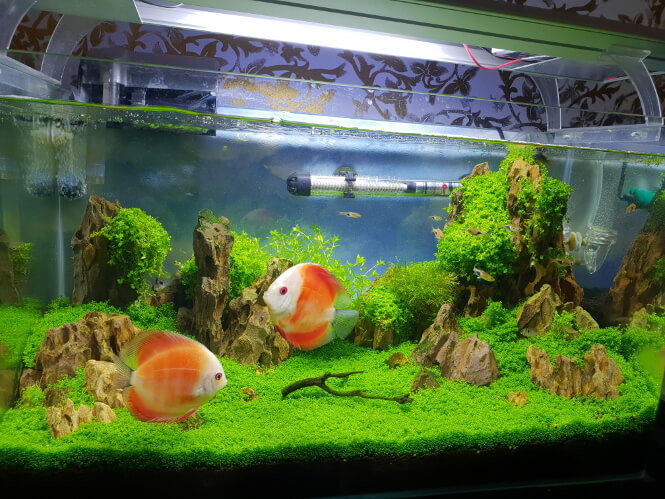
Getting more advanced aquarium lighting will guarantee you excellent plant growth. You’ll be comfortable in adding high-light plants later without considering a new purchase to fit your needs.
A dedicated planted tank aquarist will inevitably want to grow lush carpeting aquarium plants such as the Dwarf Hairgrass or Baby Tears.
Carpeting plants just look so good in an aquarium!
However, with these, you’d want a stronger lighting fixture.
Anyway, with my gear suggestions below I will be covering all possible setups.
I will explicitly mention which fixture suits your plans best, to save you time on further research.
Author’s note: You should also know that the lights I’m recommending here are also suitable for growing saltwater plants in planted marine tanks. The plants that can thrive in saltwater aquariums are usually species of macroalgae, which benefit from the red and full light spectrum.
It’s no wonder refugium lighting puts such a heavy emphasis on the same spectrum.
8. Be aware of lensing and avoid “beam lighting”
Modern LED aquarium lights use lenses in order to concentrate the beam of the diode more.
This gives more PAR and water penetration, which is good for more demanding aquatic plants, such as the carpeting ones.
Though light-emitting diodes penetrate water fantastically anyway, the top LED lighting fixtures, designed to support aquarium plants, usually come with 60º lenses.
This will give off light at a 60º angle per a single diode.
To compare, a Light Emitting Diode (LED) without a lens will give off light at a 120º angle.
As you can see this enhances performance in terms of water penetration and it may further stimulate developing plant mass in the species that are located in the outer parameter of your planted aquarium.
You’ll see where the beam ends and if your grow light does not fit your fish tank’s length perfectly there will be shadowing in the corners.
Removing some of the outer lenses will eliminate this problem.
The process of doing so is absolutely simple even if you’ve never held a screwdriver.
Here’s a short video on how to do it.
Again, this may or may not be needed, and only in the cases where your fixture does not fit your fish tank perfectly.
I made sure to recommend LED grow lights that will best fit in each tank size, but I felt like it was worth mentioning anyway.
The Best LED grow light for vigorous aquarium plant growth: My Reviews
It has been proven that LED grow lights stimulate photosynthesis rates to an extent that makes them the best artificial source of light for a planted aquarium.
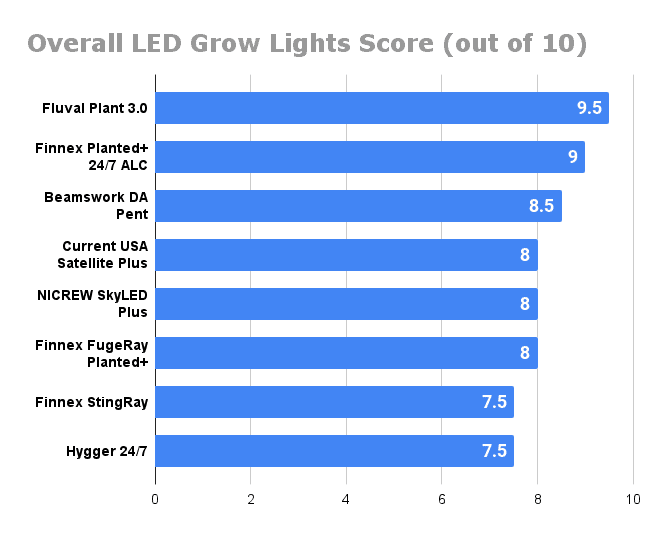
Below you’ll only find reviews of models that I’ve personally used or ones for which I have at least a couple of real-life success examples from my customers or friends.
Check out the best LED lights for explosive aquarium plant growth:
1. Finnex Planted+ 24/7 ALC – Overall Best LED for a Planted Aquarium
Before we start discussing the pros and cons of what’s probably the best LED light for an aquarium with plants, I need to make a few clarifications.
There are quite a few models of Finnex 24/7:
- CRV
- HLC
- ALC
- KLC
- CC
- SE
Although the difference is just three letters in the name, these lights can be very different from one another.
They can all grow plants excellently, but some models are better than others.
In my personal experience the Finnex Planted+ 24/7 CRV has the best spectrum and my plants have responded to it the most. I’ve used it over a standard 55-gallon tank with great success.
However, for a deeper tank, I would use the ALC version which has roughly 50% more PAR than the CRV while still harboring the Deep Red light diodes.
More PAR is useful in deeper high-tech tanks with carpeting plants (21 to 24 inches of depth).
The PAR data comparison can be found directly on the Finnex website.
You could also find additional PAR data specifically for the ALC version on the light’s Amazon listing.
Anyway, purchasing the Finnex Planted+ 24/7 ALC LED is probably the best thing you could do for your high-tech planted tank.
The engineers behind this grow light conducted actual scientific research to make sure the Finnex fixtures utilize the most efficient spectrum for photosynthesis.
My experience with it confirms their findings, at dare I say, 100%.
Turns out this model of LED lighting will grow pretty much anything in a medium-to-deep planted freshwater aquarium.
It has no issues growing demanding carpet plants or some pretentious but cool-looking red aquatic plants.
If you’re familiar with the aquatic flora you already know that, basically, red plant species require the most light to grow well and colorful.
Anyhow, the deepest tank I’ve put my Planted+ 24/7 CRV on was 21 inches, which equals the standard height of a 55, 75, and 125-gallon tank.
However, I’ve used and recommended the ALC version to many aquarists with deeper tanks and have seen great results.
Anyway, aside from their potential to support vigorous plant growth, these LED lights come with a full pack of customizable features. They are accompanied by a handy remote control, which gives you control over different weather patterns, including the 24/7 mode.
The latter will simulate a 24-hour cycle of lighting, mimicking outdoor conditions.
Though beautiful these are more of a display gimmick, so you could just put it on a timer if you want.
Anyway, the feature you could take serious advantage of is the customizable spectrum, where you’re given complete freedom.
Author’s note: CO2 injections are recommended alongside this fixture because its potent light-emitting diodes can otherwise induce algae.
I encourage you to go for the purchase only if you’re planning a medium to a high-tech planted tank.
The Planted Plus ALC fixture is physically durable and the only part I’m not really satisfied with is the plastic mounting brackets.
Finnex could probably improve this but the somewhat brittle brackets do the job of holding the unit in its place.
The brackets allow you to mount the lighting body on a brace or a rimless aquarium.
Another inconvenience I would like to mention is the overall shorter cord. No idea why it’s this short.
Good for entry-level hobbyists but also used by experienced fishkeepers (me included), the Finnex Planted+ 24/7 LED light is top-notch when it comes to aquarium plants.
I recommend it.
Advantages:- Intense with an excellent spectrum for plant growth
- Will grow virtually every aquarium plant there is
- Outstanding performance in medium-deep tanks (15 to 24 inches of aquarium depth)
- Fantastic pricing for the value you get
- Deeply customizable
- The 24/7 mode is a care-free way to look after your aquatic plants
- Brackets are designed to fit on both a rimless tank and on the ones with a brace
- The cord could be longer (it’s not super-short, but it’s not a convenient length either)
The Fluval Plant 3.0 is, in my observation, rivaling the Finnex Planted+ 24/7 in terms of performance.
I own these LED lighting fixtures personally but I also have a very close friend of mine who runs it on 2 of his display tanks.
He’s basically a guru at planted tanks and also my teacher, so to speak.
In an attempt to give you guys a piece of valuable advice I’ve consulted with him for this review.
Anyway, I can see that the live plants in his fish tank setups with the Fluval Pant Spectrum 3.0 are flourishing with growth.
This is a LED light for medium or high-requiring freshwater vegetation.
Pressurized Carbon Dioxide is recommended by definition on planted tanks that run this unit or you’ll find yourself in an algae situation.
I’ve seen the Fluval Plant 3.0 crush it on anything with 21 inches of depth, which are basically your 55 and 75-gallon standard tanks.
In terms of customization, I could say that these LEDs are slightly better than the Finnex one above.
Here, on top of everything else, you get pre-setting modes that include a “Planted Tank” mode. If you want to squeeze the maximum potential of the customization, you could ramp up the white and red and lower the blue wavelengths.
The pre-set mode will absolutely grow your aquatic plants though.
Aside from that, the body of the Fluval Plant Spectrum 3.0 LED is rather lightweight and has a sleek design.
It also has something that not many manufacturers can brag about – a waterproof rating of IP67.
A rating of IP76 basically means that water evaporation from your aquarium won’t harm this LED light, which extends the expected life of the fixture significantly.
This may be the reason why the manufacturers offer a 3-year warranty.
No other aquarium lighting can beat that.
Author’s note: – The Fluval Plant Spectrum 3.0 LED is, in fact, more durable than the Finnex Planted+ 24/7, from my observations.
Another pro I think is worth mentioning is that the lenses of this fixture allow for 120 degrees of illumination, completely eliminating the beam-light effect. No shady corners in your planted aquarium whatsoever.
Anyhow, an issue I would like to point out with the Fluval Plant 3.0 is the App, which controls the light customization.
This LED light is relatively new to the market and the App needs some polishing.
From time to time there may be connectivity issues, which completely removes your control over the lighting in your tank.
Another thing is that if there’s a power outage the light will get stuck on blue until you come home and reset the settings from your mobile phone. Too long of this and algae may sprout (though we’re talking days, here).
Nevertheless, the Fluval Plant Spectrum 3.0 is an overall great LED light for freshwater planted aquariums that aim at keeping thriving live plants.
It is somewhat new to the world of planted tanks, but it’s already risen to the top.
If you have the budget and the right setup in mind – go for it.
Advantages:- Grows pretty much any aquatic plant
- Efficient for medium-deep aquariums
- Has pre-set grow modes that work for aquatic plants
- Detailed customization available
- The lightweight sleek body design
- Waterproof certified (IP67)
- 120º lensing for maximum spread of the beam
- 3-Year Warranty and is very durable overall
- After a power outage, you have to reset the settings from the room where the aquarium is
- May seem pricey, though that’s normal for a premium product of this class
- The app. Even though it’s been so long since it came out, the app still is somewhat weird to navigate and not as user-friendly as I’d like it to be at this price point.
3. Current USA Satellite Plus PRO – Ideal for stem Plants in Medium-Deep Tanks
Click to compare pricing + see MORE photos of this product at:
My experience shows that in a tank with a decent depth such as the 55-gallon and the 75-gallon ones, which are both 21 inches deep, the Current USA Satellite+ PRO could absolutely look after your medium-light plants.
That type of vegetation I’m referring to basically includes stem aquarium plants and, sometimes, an easy-to-grow carpeting plant.
The spread of light is decent and it covers the whole planted tank well.
This LED fixture does not provide sufficient lighting for demanding red plants or at least not enough to stimulate explosive growth rates (red plants, for example).
Following these thoughts, I would run the grow light over my medium-depth fish tanks that are very heavily planted but do not contain super difficult aquatic plants.
This way I’d take advantage of the Satellite+ PRO’s potential to the fullest.
Aside from plant growth, this LED grow light is the perfect addition to a display planted tank.
Why? Because it has tonnes of fancy features.
The Current USA Satellite+ PRO is programmable to simulate all kinds of weather patterns, including thunderstorms or passing clouds.
The timer that comes with it is better than your usual one, as it remembers the settings even after a power outage.
The only thing that you need to keep in mind is that you have to manually turn it on after the power comes back.
The Satellite Plus PRO lighting fixture also comes with a remote which, at least to me, is pointless because it only works on a very close range.
Do make sure you run this LED light over a glass top because the body is not waterproof and water evaporation from your planted aquarium may damage it.
I’d purchase this product, if I wanted to have a beautiful, heavily planted 55 or 75-gallon tank, that would not contain difficult live plants.
Just a quick note that if you’re going to shop anything Current USA, then Chewy.com is your friend.
They always have it on some kind of discount, it’s never out of stock and, often, the prices will beat even those at Amazon.
Advantages:- Supports the growth of medium-light stem plants fantastically
- Has a beautiful natural spectrum
- Spectacular show-off modes
- Blue LED diodes do not induce algae
- The timer is better than most
- More expensive
- Not waterproof (run it over a glass aquarium hood)
- The remote control does not work over long distances
4. NICREW SkyLED Plus Lights – Perfect for Tanks with Below-Medium Depth on a Budget
The NICREW SkyLED Plus is the type of light I would be skeptical to get at first.
Although it’s extremely popular among fishkeepers, to a beginner it may appear too inexpensive to actually grow plants.
Fortunately, along with the next entry (the Beamswork Pent), the NICREW SkyLED Plus has managed to stay afloat as one of the best budget lights for a planted tank.
I’ve seen this light grow low-to-medium demanding plants pretty well in tanks that are between 12 inches and 18 inches deep. In fact, the SkyLED Plus would even cause some algae issues if the tank is 12 inches deep and the fixture works at 100% power.
To avoid unwanted algae in such shallow tanks, which is basically the 10-gallon Leader, I recommend stuffing your aquarium with plants to the brink.
From my observation, covering all of the substrate with plants ensures that the algae won’t outcompete them.
Anyhow, the NICREW SkyLED Plus can also be used in an 18-inch deep tank with success if you’re growing low-light plants with a couple of medium ones here and there. An example of a standard tank with this depth would be the 29-gallon one.
Anyway, the spectral light channels themselves are dimmable, which is a fantastic feature to have at the price point of this LED light.
The blue “night” mode looks cool but is overall useless when it comes to plant growth.
However, the “daylight” mode is incredibly bright and it also includes diodes that provide red light in the 660 nm wavelength range.
I’m assuming the latter is why the NICREW SkyLED Plus performs so well with aquatic plants, given its price.
The full spectrum mode also makes the more vibrant fish really pop with color.
Author’s note: The brightness of the SkyLED Plus LED lights may shock you at first. Some users even report tuning the intensity down, just because it seems too bright.
To me, the brightness levels of this light are not surprising as it reportedly has the most PAR out of all the other NICREW models.
Anyhow, the SkyLED is also built from aluminum whereas the first generation of NICREW lights was built from plastic, with the exception of the longest fixtures.
And finally, a con I would like to mention about this aquarium light is that it does get warm to the touch.
I would not consider it dangerous, but it can raise the aquarium’s water temperature by a degree, so keep that in mind.
Advantages:- Budget-friendly
- Can grow low AND medium-light plants
- Way more durable than the previous models
- Brightness that makes your tank pop with color
- Slick design
- Extendable brackets which helps it fit on more unconventional tanks
- Gets noticeably warm
- Brackets can sometimes seem loose
5. Beamswork DA FSPEC 0.50W Pent – Brighter Than You Might Expect
The Beamswork DA FSPEC 0.50W Pent is a slightly upgraded version of the Beamswork EA FSPEC.
A slight upgrade, however, does not mean a slight difference in performance.
Author’s note: I’ve used both of the DA and EA models when I was building my tanks on a tight budget and I was pleasantly surprised with the results.
The EA FSPEC is more than enough for a low-tech planted aquarium setup in a shallow (up to 12″ deep) tank. The EA version will support the basic low-light plants known in the hobby.
Anyway, the Pent will ultimately work for a 10 Long, 15, 20, or 30-gallon breeder planted tank that’s high-tech in nature. Again, tanks with 12″ of height.
However, at this depth you should make sure the tank’s bottom is covered with plants and that you have a CO2 system in place. Otherwise, you risk getting hair algae to bloom or making the water green, which can be annoying to treat afterward.
The risk of algae bloom is because the Beamswork Pent really is intense. In fact, it is one of the most intense LED lights you can get on a budget.
Following these thoughts, you could use it on deeper planted tanks too.
I even sometimes recommend lining 2 Pent LED fixtures next to each other to light up planted aquariums with 24 inches of depth. However, that’s only in the case where the tank is 72 inches long and the aquarist wants 6-foot long LED fixtures to match the length.
Anyhow, the Beamswork Pent LED light will support the growth of aquarium plants that require a lot of light, which, given its price, is more than welcome.
The Pent’s spectrum is not as optimized as Finnex and Fluval’s, but you can still get a good amount of plant growth.
Speaking of which, the Beamswork Pent LED light is on the inexpensive side because you don’t get any additional features.
You don’t even get a timer. You should, however, get the separate timer/dimmer Beamswork offers which you can see here.
Without a dimmer, you still risk inducing algae in shallow tanks.
Anyhow, the daylight spectrum brings out colors of fish and aquarium plants alike nicely, giving your planted tank a really attractive tint.
The cons here would be that the Light Emitting Diodes do not provide a perfect blending of the beam and if the water surface gets too excited by your filter or aerator you might notice a slightly disco-colored bottom.
To avoid that I recommend that you get these light fixtures if the substrate in your aquarium is a darker color.
If your plans for a planted aquascape fit in this description then get either model and call it a day.
I give the Beamswork LEDs thumbs up.
Advantages:- Very competitive pricing
- A sleek and simplistic design
- Will grow medium to high-light plants in shallow to medium-deep setups
- Spectrum makes the colors of aquatic plants and fish pop
- No extra features whatsoever
- A timer / dimmer should be bought separately (use the one Beamswork offer themselves – it’s worth it)
- If the substrate is a light color then you might notice the disco-effect of beams not blending too well (just go with a darker substrate, such as Black Diamond Blasting Sand which looks good in a planted tank anyway)
6. Finnex StingRay – Perfect for a 5-gallon low-tech tank
As the title goes this LED light will serve smaller planted aquariums pretty well.
If you plan to have a small, 5-gallon tank that’s planted and also has a couple of nano fish, or a Betta in it then the Finnex StingRay may be your best bet in terms of lighting.
Low-light aquatic plants will thrive under it as Finnex made sure the spectrum is in the sweet spot of wavelengths for photosynthesis.
Though the illumination isn’t enough for more demanding greenery the Kelvins are at 7000, which is great for the overall colorful look of the tank and fish in it.
You won’t be getting any fancy customization, by the way – just an ON and OFF switch.
If you are planning on such a setup, you’ll be satisfied with the growth of your aquarium plants and also with the durability of the fixture. Finnex is known to make long-lasting equipment in the freshwater aquarium lighting industry.
The cons of this unit are the usual suspects – the plastic mounting brackets and the shorter cord.
Both of these can be somewhat annoying but they won’t really impact how the live plants respond to the spectrum of these LED lights.
Get this light if you’re having a small, planted tank that’s low-maintenance and has a Betta or some other nano fish in it.
Advantages:- Beautiful daylight spectrum that makes your aquarium plants pop out
- Grows low-maintenance plants in shallow aquariums (no more than 10 inches deep)
- Simple and sturdy build
- No customization
- Mounting brackets are somewhat flimsy
- The cord is shorter than with your usual aquarium lights
7. Finnex FugeRay Planted Plus – Grows Difficult Plants in Medium to Deep Tanks
The Finnex FugeRay Planted+ is a super bright aquarium light that grows high-demanding live plants.
I’ve personally used it on my 30-gallon tank with standard height to grow an underwater carpet.
FugeRay did not have any problems with making my red plants flourishing either.
That’s a depth of 12 inches.
However, this fixture is good for aquarium lighting on any high-tech planted tank that has no more than 48 inches of length.
This may be so because the diodes of the FugeRay are heavily leaning towards the red wavelength of the spectrum.
As we know the red light with 660 nanometers of wavelength is where it’s at for plant growth.
Frankly, the Finnex FugeRay Planted+ is really the best light I can think of for tanks with greenery that demands raw power.
As for the cons, there are not many.
A major one would be that the build is not IP67 waterproof certified, which means you’d have to position the fixture over a glass lid.
Obviously, this will extend the expected life of the product.
Another thing is that the light does get a little warmer than your usual LED lighting but it’s not actually hot or anything, so there’s that.
It has a night mode, but I would recommend avoiding that as the blue light could induce algae in your planted aquarium.
Though you probably figured that out, I think it’s also worth mentioning that you should use CO2 in such a setup, to further reduce the chance of algal spores developing.
And finally, the FugeRay Planted Plus doesn’t have a dimmer and I haven’t found a good one for it.
This can be a big con because if you discover that the grow light induces algae in your tank, you’d want to either:
- raise it;
- return it;
- introduce more plants to the tank.
Author’s note: Essentially the FugeRay Planted+ packs a slightly stronger punch than the 24/7 ALC in terms of intensity.
However, price-wise they are almost equal but the ALC has different modes and way more controllability.
Following these thoughts, I would get the FugeRay Planted+ if I wanted to run a tank with very high-demand aquatic plants.
It also makes sense to use this LED light on very deep tanks such as the standard 90-gallon one.
Advantages:- Spectrum leans on the red (660 nanometers) which is excellent for high-demanding aquarium plants
- Powerful output
- Gives a very eye-pleasing pink-ish tint to a planted aquarium
- Is fantastic for high-tech setups
- Lightweight and thin body
- Not dimmable
- Short cord
- Plastic brackets
- Rarely it may start flickering (Use a Q-tip with 99% alcohol to clean the circuit board if that happens – it’s a one-time fix and you’re good to go)
8. Hygger 24/7 – Good customization in a budget light
So the Hygger 24/7 can be a good alternative to the other budget aquarium LED lights such as the NICREW SkyLED.
On that not the SkyLED will grow aquarium plants slightly better.
What I liked about the Hygger 24/7 when I tested it on my own fish tank was its customizability.
At its price point you can’t beat that.
My aquatic plants responded well to it and I started seeing results almost immediately (read “a week”).
The previous light on this tank was a a basic one from an all-in-one kit.
Another thing I think makes this budget LED light stand out is that it’s made with waterproof gluing.
This shields the lighting diodes from water vapor coming from your fish tank which extends the live of the fixture.
Author’s note: I’m trying to be careful with my wording about the waterproof thing because the Hygger 24/7 doesn’t have an official IP rating, as is the case with Fluval’s Plant Spectrum 3.0.
Anyway, so far so good.
Seemingly the Hygger 24/7 rivals the premium LED lights on this list with its customization options while being a fraction of the cost.
So where’s the catch, Momchil?
Well, the 24/7 feature is not well programmed – the light starts to dim too early in my opinion. This makes the timer kind of useless, which can be a deal breaker to people who like a more hands-off approach.
In itself the timer is pretty basic and limiting though if it were programmed better it would’ve been very useful.
Also, although this did not happen to my Hygger 24/7, there seem to be some dud batches that break around the 1-year mark.
Mine works fine to this day, far surpassing the 1-year mark.
So if you’re up to getting the Hygger 24/7 consider that there’s a small chance yours is from the dud batches.
Advantages:
- Great price point
- Excellent plant growth for low-light plants
- Great for shallow aquariums
- Pre-set 24/7 mode simulating the natural daylight cycle
- Diodes are sealed with a waterproof material, protecting the fixture from fish tank evaporation
- Timer is basic and not programmed too well (it can still do its job, depending on your setup)
- There’s a chance you get a dud batch which seem to last around a year.
Which LED lights should work best according to your planted aquarium’s gallon capacity and depth?
I’ve motivated and explained in detail each of my size-related recommendations in my general guide on LED aquarium lighting. You can click this link to check it out. Right at the top of the guide, you’ll find a table containing each tank size. Find yours and click on that to see why I’m suggesting this precise model for this setup and aquarium dimensions.
That being said, the best LED lighting according to your planted aquarium’s gallon capacity and depth would be:
- 5-gallon tank with low-demand plants: Finnex Stingray
- 5-gallon tank with high-demand plants: Finnex Fugeray Planted Plus
- 10-gallon tank with low-demand plants: Beamswork EA FSPEC
- 10-gallon tank with high-demand plants: Finnex Fugeray Planted Plus
- 20-gallon LONG tank with low-demand plants: NICREW SkyLED Plus
- 20-gallon LONG tank with high-demand plants: Beamswork DA FSPEC 0.50W Pent
- 20-gallon HIGH tank with low-demand plants: Beamswork EA FSPEC
- 20-gallon HIGH tank with high-demand plants: Finnex Planted+ 24/7 CRV
- 30-gallon tank with low-demand plants: Beamswork EA FSPEC
- 30-gallon tank with high-demand plants: Beamswork DA FSPEC 0.50W Pent
- 40-gallon tank with low-demand plants: NICREW SkyLED Plus
- 40-gallon tank with high-demand plants: Finnex Planted+ 24/7 CRV
- 55-gallon tank with low-demand plants: Current USA Satellite+ PRO
- 55-gallon tank with high-demand plants: Finnex Planted+ 24/7 ALC/CRV OR Fluval Plant Spectrum 3.0
- 75-gallon tank with low-demand plants: Current USA Satellite+ PRO
- 75-gallon tank with high-demand plants: 2x Finnex Planted+ 24/7 ALC OR Fluval Plant Spectrum 3.0
- 90-gallon tank with low-demand plants: 2x Beamswork DA FSPEC 0.50W Pent
- 90-gallon tank with high-demand plants: 2x Finnex FugeRay Planted Plus OR 2x Finnex Planted+ 24/7 ALC OR 2x Fluval Plant Spectrum 3.0
- 125-gallon tank with low-demand plants: Current USA Satellite+ PRO
- 125-gallon tank with high-demand plants: Finnex Planted+ 24/7 ALC/CRV OR Fluval Plant Spectrum 3.0 OR 2x Beamswork DA FSPEC 0.50W Pent
Though I’ve mentioned the answers here, I also have a separate guide on choosing lighting for a 125-gallon planted aquarium, because not many manufacturers offer a 72-inch long fixture and fitting can be a nuisance.
Should you go for the more cheap LED lights if you’re on a budget?
Mind that all the LEDs I am listing here are on the inexpensive side, given the industry’s tendency to overprice equipment.
You could absolutely find aquarium lighting that goes up to $400 and it will grow live aquarium plants just as well.
However, the models I reviewed above can all be considered budget-friendly and you’ll be getting the best bang for your buck if you decide on them.
As I said these grow lights have proved themselves to me and others countless times already, just make sure to get the right one for your planned plant setup.
That being said, going for a cheaper LED light for your planted aquarium, should not necessarily mean low quality, but, say, limited customization and only sufficing for a setup with low-maintenance plants.
You could say that the fixtures in my guide are the best performing aquarium lights for the money.
For how many hours a day should I leave the LED grow lights on?
The main indicator your plants are not getting enough light is slow or no growth at all. In general, some leaf discoloration may also occur but these are mainly caused by nutrient deficiencies in the plant.
Here’s a general lighting schedule for your aquarium plants:
Typically, most freshwater aquarium plants will thrive on 8 hours of full aquarium lighting.
If you leave the grow lights on for between 8 and 10 hours, there will be an abundance of light that may be further employed by algal spores.
Author’s note: Leaving on any actinic light during the night, also known as “night mode” may also induce algae because the blue and ultraviolet spectrum are utilized by most algae species.
If green hair algae or, perhaps, Black algae start appearing in your planted aquarium – reduce the daily lighting schedule to 6 hours which should be enough for your live plants, but will suffocate the algal growth.
Additional tricks to further boost the growth rate of your aquarium plants
Having the right aquarium lighting is just 50% of the equation.
You should be able to recognize what’s the best aquarium fertilizer for your aquatic plants if you want to achieve a contest-worthy planted tank. I have a guide on those over here.
I made it very beginner-friendly and you’ll almost immediately discover the right aquarium fertilizer for your setup. Visit the link and have a quick skim over it.
Anyway, the basics of it are that the fertilizers go in either the water column when in liquid form or in the substrate when they come as root tablets.
Speaking of substrates, there are ones that are specially designed to grow aquarium plants. If supplementing macronutrients with fertilizers is not your thing you likely need a good substrate for 100% healthy and thriving growth.
However, some of these substrates will be expensive, yet won’t contain the key nutrients advertised on the bag.
To sort out the good from the bad ones and to help you understand the whole nature of substrates for aquarium plants I’ve created this beginner guide.
Give it a skim and you’ll learn how to distinguish quality from phony advertising.
And before we finish – do your research on a good CO2 regulator so that your planted aquarium could benefit from a stable and precise dosing of Carbon Dioxide.
FAQs
What is the best one for optimal plant growth?
The best LED light for plant growth is the one that is powerful enough to send light in the right spectrum right to the bottom of your tank.
For freshwater aquatic plants, the best spectrum is usually the red and green one, according to the scientific research. Red penetrates water the least, so it’s important that your LED aquarium light sports dedicated red diodes.
What color should one emit for aquarium plants?
Generally speaking aquarium plants grow best under a combination of red, green and blue light. White light is a combination of those so it also works well, depending on the spectrum proportions.
The most important light color for plant growth is red. Also, a tiny portion of blue will stimulate stem and leaf fullness. Too much blue light will likely result in an algae outbreak in the aquarium.
Will 5000K ones grow aquarium plants?
5000K is what is known as “natural white” light. White light can be a combination of different proportions of red, blue and green light.
Since Kelvins are only used to measure what color the light appears to the human eye, they are not a good way to assess quality of light for plant growth.
That being said, if your 5000K LED light has a decent amount of red and green in its spectrum then it will probably grow aquarium plants well.
Which one is the best for preventing unwanted algae growth?
Algae sprouts in aquariums that receive too much light that is not being used by the plants in the tank. Algae spores start employing the unused incoming light and use it to grow.
One way to control algae outbreaks in your aquarium is by reducing the intensity of your LED light. Another way to decrease the incoming light is to move the tank away from sunlight from a nearby window.
Finally, planting more plants in your aquarium will result in less available light for algae to use. Heavily planted tanks rarely have algae issues.
Over to you
After finishing this article you should be confident and knowledgeable enough to make an educated choice.
Explosive plant growth will come as long as you follow the instructions and pick the best LED grow lights for your setup.
I wish there was someone who’d sit and tell me all the things I had to learn the hard way throughout the years.
If you’re still unsure or have a custom planted aquarium, tell me in the comments and I’ll do my best to offer you a piece of advice.
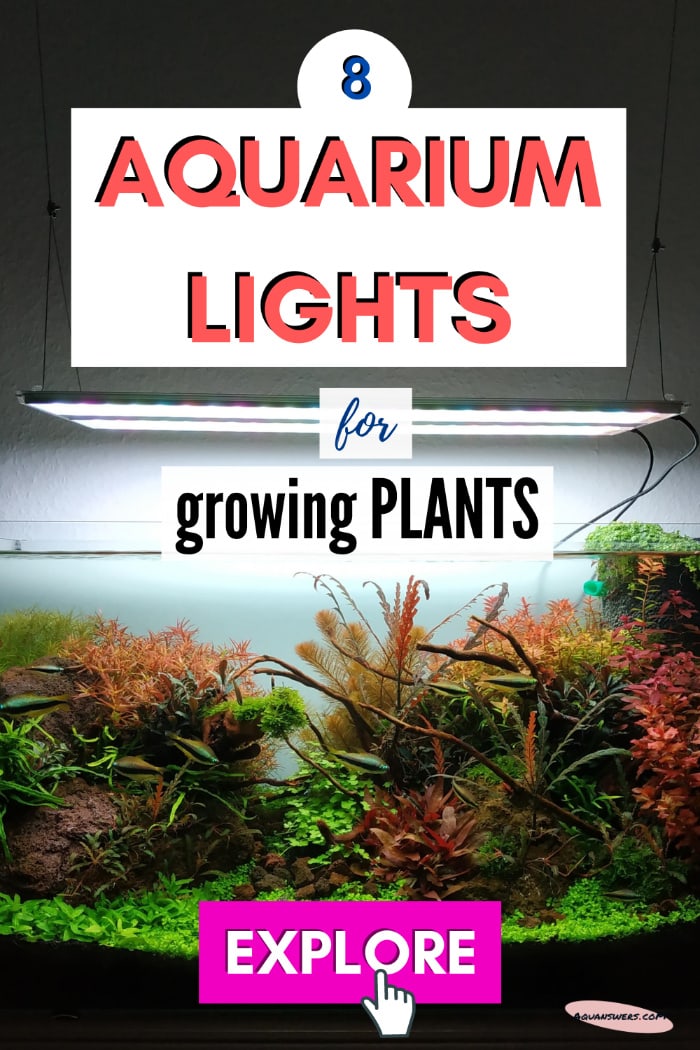

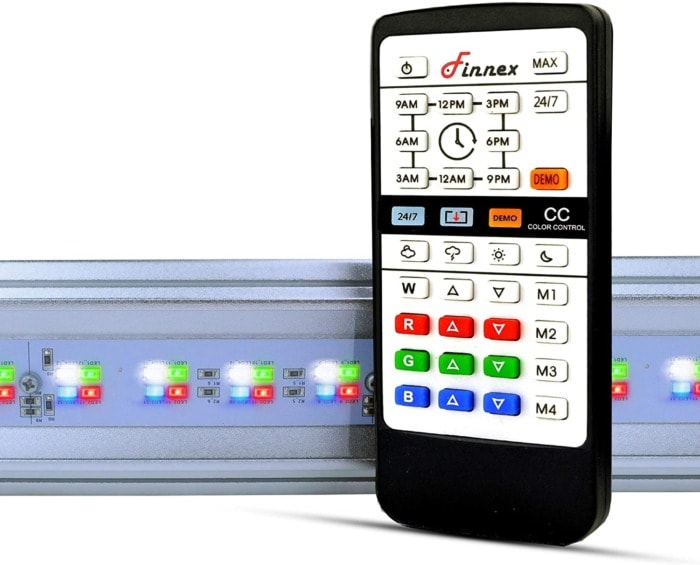
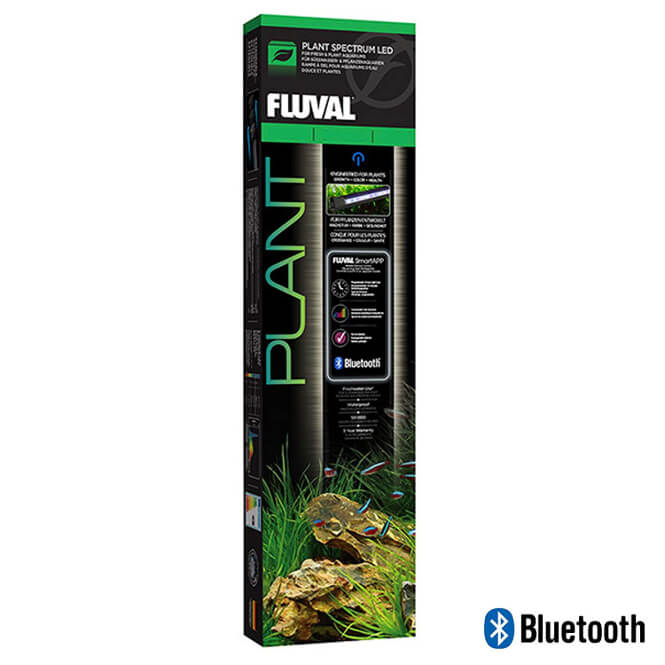
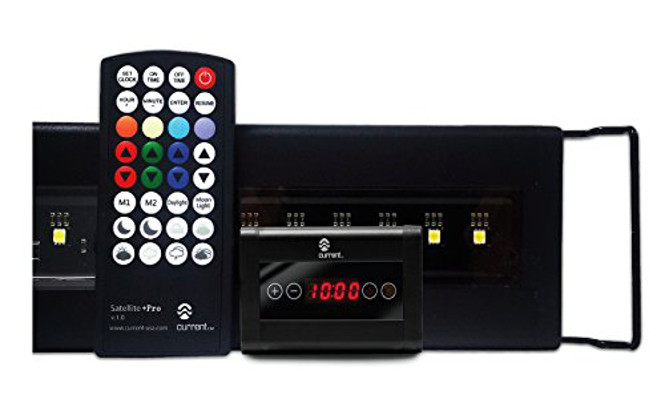
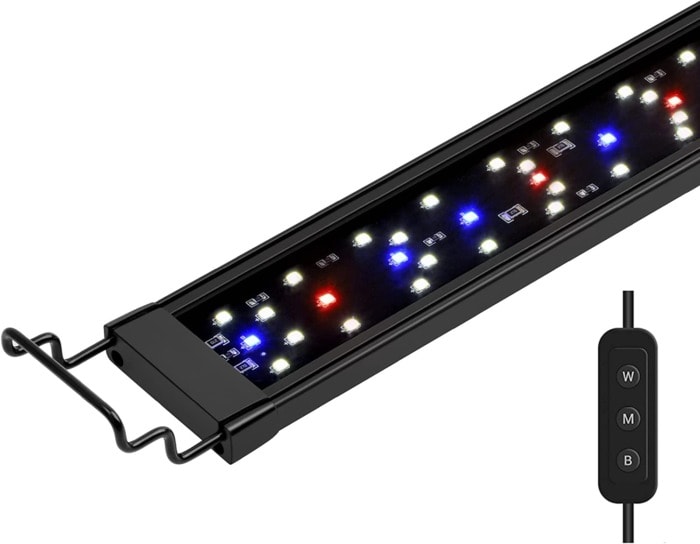
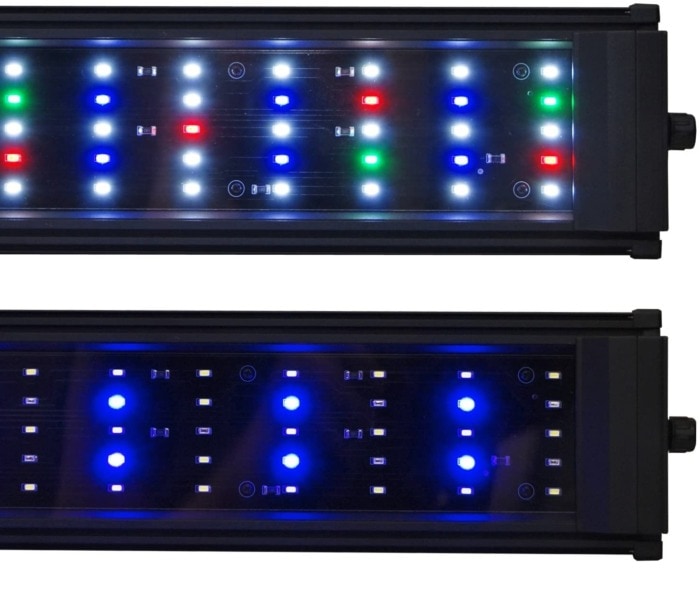
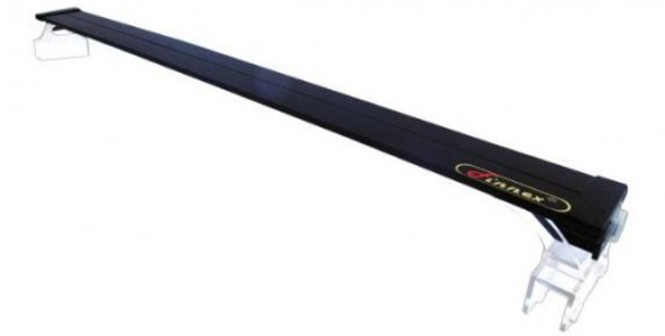
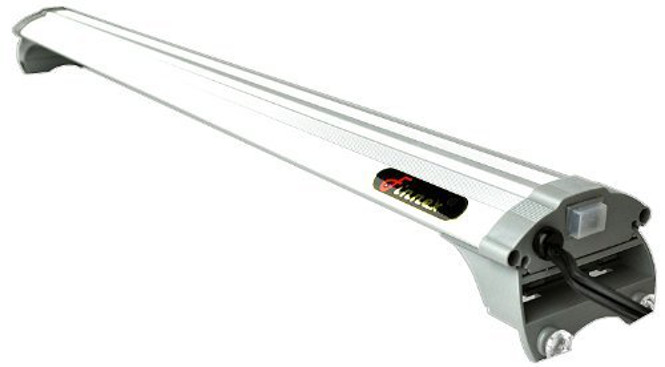
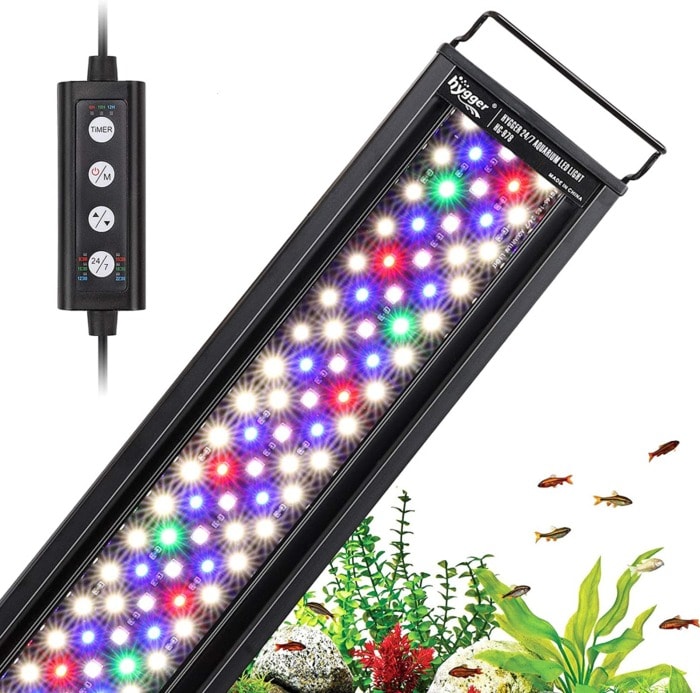
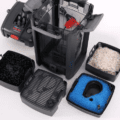
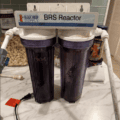
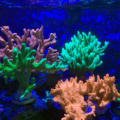
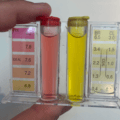
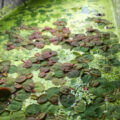
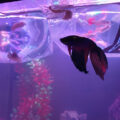
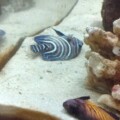
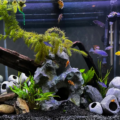
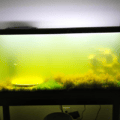
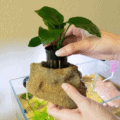
I have 3x Chihiros vivid2 lights. Tank is 160cmx60cmx60cm approx 680l planted hightech tank. Problem is hair algae and other green. Lights setup is red60%, green60%, blue 50%. 7h with 0.5h ramp time included. 50% water change every week and flourish 12.5ml and nitrogen 15ml once in the week. Do you have any thoughts should i change light values?
Hi, love the informative articles!
I had a question about general RGB levels for the Finnex ALC on a 55 gallon tank. Been using one for about a year and my plants are surviving but not thriving. My old life glo t8 fluorescent bulbs were giving me better growth.
I’m wondering if I am using too much white as the majority of my light. Before reading this article, I was using intensities; W60% R20%, G30%, and B10%.
I know there are many variable and every tank is unique. Should I be running intensities; W20%, R70%, G50%, and B20%. Basically, more color LEDs and less white? I have low tech plants such as ones you listed above. And also dose fertilizers. Just looking for some general guidance on this light specifically.
Thank you for any feedback,
Hi, Jay,
Thanks for reading Aquanswers.
I would ramp up the red as, according to the research, it gives the best results for all plants.
The study suggests that the optimal proportions would be at least 50% red, no more than 25% blue, and the rest could be green. Even 50% red and 50% green performed better than any combo including a separate blue channel.
So here’s how that translate into your situation:
You have 4 channels of light. Ideally, you’d want 50% of the overall intensity to go the red spectrum. Whatever intensity percentage you have for your red, consider this to be “half” of the total intensity. For example, you could have 50% red, 20% blue, 30% green, 0% white. If you want to keep the proportions in the example while maximizing the incoming red light you could do 100% Red, 60% green, 40% blue, 0% white.
If you wonder where does white come in – pure white light (in the context of LED lighting) consists of a majority of green and blue, plus some red. “Warm” light contains more green and red and less blue.
So if I decide to use white in my mix of channels I will reduce the pure blue channel because pure white already contains almost half of that.
Following your example where you have your red at 70%, this means that, IDEALLY, I would spread the other 3 channels in a total of another 70%. If I were to combine that rule with the findings of the study I’d do: 40% green 20% white, 10% blue.
Hope this helps.
Momchil
I absolutely love reading your articles! They are very informative and to the point. I’m in need of your advice. I have a 10 gallon aquarium(12″ high) with Brightwell Rio Escuro F (active) substrate that is 3 inches in depth, 11 vallisneria plants, and 1 beta fish. I do weekly 50% water changes using tap water with Seachem Prime. The aquarium uses 2 sponge filters for filtration (1 on each corner in the back) and has a clear glass top. I’m using CO2 but it is not a pressurized system it is a passive system that uses water flow to disperse it. It’s an older style Fluval system. I have a drop checker in the aquarium and it’s not enough CO2 to turn the liquid from Blue to green. I guess it’s being used more to supplement the plants more than to “push” them to grow. I’m using the Fluval 3.0 plant light (15-24″ extendable arms) mounted on the aquarium top using the extendable arms. I’m currently using 1% on Blue and Pink. 25% on Cool White, Warm White, and Pure White. Is this too much or too little light? What would you recommend since I’ve only been doing this for about a month? Your advice will be so helpful to me and my aquarium! Keep up the great work you do!!
Thank you very much for posting this. So much useful information. I would like to ask for suggestions to my current lighting setup and schedule. Tank is two months old and i can’t seem to get rid or reduce what it seem like Green Dust Algae. There is some on the glass but most noticeable on the sand substrate. Plants are thriving except Rotala Macandra turned green. Here is what I have:
Tank: 50 gal Waterbox
Filter: UNS Delta 90
CO2 Injected
Twinstar Algae Inhibitor
Lighting: 2 AI Prime which sit 24″ above the lowest part of the tank.
Schedule as follows:
1200-1600 (ramps up and down 30 mins)
Blue – 20%
Green – 60%
Deep Red – 90%
Moonlight – 0%
Warm White – 30%
Cool White – 50%
1600-1800
Blue – 10%
Green – 0%
Deep Red – 0%
Moonlight – 0%
Warm White – 3%
Cool White – 0%
1800-2000
Blue – 0%
Green – 0%
Deep Red – 0%
Moonlight – 10%
Warm White – 0%
Cool White – 0%
Stock – 26 ember Tetras
Plants: Montecarlo, Rotala, ludwigia red, Pearl weed, hair grass, S Repens, H Tripartitta, xmas moss and a few buce
Hardscape: Seriyu Stones
Substrate: Fluval Stratum, Sand
Ferts: Potassium, Phosphorus, Iron, Trace (Seachem dosing schedule)
I appreciate your help in advanced
Hello Jun, thanks for your kind words!
From what I can tell you did a pretty good job with the setup.
Anyway, I think that your tank is somewhat new and has some maturing to undergo still. During the first couple of months, it is usually normal to experience some algae growth, with diatoms being the common intruder. If the green dust algae are not too overwhelming I would not worry about them but I do think the extended periods of blue light have something to do with it.
If it’s not too intrusive on the eyes, I would switch the percentages of your Warm White and Cool White channels making them: warm – 50% and cool – 30%.
Apart from that, I see that for 4 hours straight (if I understood correctly) you run primarily blue or mixed-blue lights. “Moonlight” I’m assuming has a lot of blue in it and “Blue” is blue…
This could be an issue because some types of algae are very good at exploiting blue light for their growth.
Hope this helps!
P.S. – The lower the Nitrate levels you maintain – the redder your Rotala Macrandra would be.
Best,
Momchil
Thanks for the quick response Momchil! I have switched the warm and white percentages like you’ve suggested. it is a little intrusive on the eyes but i am willing to give myself time to adapt. Why the switch in levels may I ask? Luckily I have not been invaded with Diatoms (yet).
Moonlight channel on AI Prime is just like warm light but a lot weaker.
Lastly, will bumping the red from 90 to 100 and green from 60 to 70 (like i’ve read on some of the comments above) provide any benefits?
Hey again,
The switch was to further reduce the blue spectrum because warm white has more red and cool white has more blue.
Bumping up the red and green percentages may be beneficial for plant growth. I don’t know if the change would be noticeable though.
Regards
Thanks again for the advice. I truly appreciate what you do and for sharing your knowledge.
Great article..I wish I had read before my purchase. I had purchased a Fluval Aquasky 3000 – 250000 K, because I was only going to to grow low-med light plants. The issue is I have a 30 gallon tall aquarium with the length being 17 3/4 inches across but its 23 inches deep, although I have a couple inches of substrate to shorten that depth. I am concerned because I could only get the shortest model that only provides 12 watts. Is this going to provide enough light? I am debating buying a second one and using 2 but would this still be enough for this depth?
Hi Fred!
In my opinion, you’re on the right track with your thinking.
In your particular case… I would go with a second Aquasky fixture. Tall tanks are always tricky, but I’m confident a second fixture would allow you to grow any low to medium-light plants on the substrate.
For reference, the Aquasky has around twice less PAR than the Fluval Plant 3.0, but for your aquarium’s dimensions 2x Aquasky should be enough and let you grow the plants you want.
Best,
Momchil
Dear All
I am based in England and I am seeking your suggestions regarding aquarium lighting.
I have a bow front 100 litre planted tank, and I want to grow carpet plants in it.
The tank is a “tall” tank – from lights to substrate around 24” is the distance.
Please advise me the best lights, which can be fitted under a hood (approx 620 mm long and 90mm inch wide space in hood)
I don’t have too much budget so please advise accordingly – my target is around 80-90 PAR at the substrate (with the water filled in the aquarium)
Thank you for your help!!
Best regards
Sam
Awesome information on this site! I have a couple of follow-up questions please, regarding the right settings for my LED light. I’ve been experimenting with the settings for the past 1 year and am yet to achieve optimal combinations.
Tank size: 30 long (36x12x16.75)
Plants: amazon sword, java fern, anubias, duck weed
Fish: neon tera, von rio flame tetra, julie corydora, otocinclus
Light: Finnex Planted+ 24/7 VL-CRV36
CO2 injection: none, but 1 ml/day of NilocG Enhance (glutaraldehyde – algaecide) is used.
Fertilizers: Thrive capsules for the amazon swords + PPS Pro DYI macro (1ml/day) and micro (0.5 ml/day) with 30% weekly water change.
Substrate: white sand
The Finnex 24/7 is evidently too much for my low-tech tank. My tank has been established for 6 years and I upgraded my old T8 fluorescent Hagen Power-glo light to the Finnex LED 1 year ago. That’s when all the algae and slime problem began. Green algae, brown algae, black beard algae, everywhere in the tank. Never had these with the T8 light. After 15 months of adjustments, the BBA is now almost gone but some green algae still forms in the upper half of the top of the tank (on driftwood and on leaves that reach the upper half of the tank) and brown algae still forms at the bottom (on the glass walls as well as driftwood and stones in the bottom parts of the tank). The sand substrate also has a thin, slimy, top layer of gunk and sand combined. This never existed with the T8 light.
LED Light intensity setting evolution:
Month 1: W-100%, R-100%, G-50%, B-50% – instant algae, java ferns struggled with high light.
Month 2: W-70%, R-70%, G-70%, B-70% – all algae still thriving. Fish and plants struggling.
Month 4: W-60%, R-60%, G-60%, B-60% – all algae still thriving.
Month 6: W-50%, R-40%, G-0%, B-40% – BBA reduced, green & brown algae still thrive.
Month 10:W-40%, R-40%, G-0%, B-40% – BBA reduced further, green & brown slightly reduced.
Month 13:W-30%, R-40%, G-0%, B-40% – BBA almost gone, green & brown remain in reduced amounts but still need weekly wiping. Slime layer on sand substrate still forms. Java ferns not dying. Anubias and swords thriving.
Month 15: present – suggestions please?
Finnex 24/7 applies gradient intensity for every 3 hr cycle. I wanted to have one photo period in the morning and one in the evening when I’m home. All the above settings were set for 9 am and 6 pm only. All other set points on the remote (12 pm, 3 pm, 9 pm, 12 am, 3 am & 6 am) were blacked out (0% for all). So even with this configuration, there is a total of 12 hrs of light/day with varying intensity, since Finnex starts the gradual ramp up 3 hours before the set point and the ramp down for 3 hrs after the set point. For example, for the 9 am setting in month 13, the white (W) LEDs will start from 0% intensity at 6 am and slowly ramp up to 30% by 9 am, and then slowly start ramping back down from 9:01 am and reach 0% again by 12 pm.
While the algae problem is considerably down now, it still is nowhere close to how fine things were with the T8 fluorescent light. Maybe reduce the R% further and increase G% a bit? Any other combination of RGB and W? After more than a year of trying, I’m thinking of just going back to the T8 light at this point. My fish were happier too before. All my cories have lost their barbels since I switched to LED light and the algae & slime problem started. They are still alive and eating, but I don’t think they’re thriving. On that note, I started using Enhance (glutaraldehyde) only after the algae problem with LED started. Could this be another cause for loss of barbels?
If you have any recommendations for further customizing the light settings and/or changing anything else in how the tank is being run, kindly let me know. Thanks.
Hi TKP,
Thanks for describing your situation in such detail – that greatly improves my chances of helping you out.
From what I can tell your photoperiod seems fine (not too long). Though it’s true that the Finnex 24/7 is not recommended for this aquarium depth I would not advise getting rid of it yet! T8s need occasional changing of the bulbs, etc. so if you manage to control your “beast” it can become your best friend in the long term… 🙂
The first thing I would try is to reduce the blues to about 1/4th the intensity of your red channel. I would also add some green, but not much. I would make it something like this: W-30%, R-40%, G-10 to 20%, B-10%. See if that helps. White also contains green and blue wavelengths, so if you end up reducing the red with another 10% (setting it at 30%) then you could likely turn off the blue light channel altogether. I mean you do have a low-tech shallow tank, so it should not be a problem, in my opinion.
Onto your other question – Use only half the recommended dose of Nilocg Enhance and do not use it continuously. It’s a great product but it should be used with caution. It can definitely harm the more fragile fish in the tank and that’s what happened to your cories, I’m assuming. I would stop using it for now and only play with light intensity. For the record, the product likely uses an isomer of glutaraldehyde, which is less reactive than the actual stuff, but still somewhat dangerous to fish.
I also have an article about removing Black algae which you may find very, very helpful. Use the search bar of the website for that (or if you can’t find it I will leave you a link to it). Try to remember if you started or changed fertilizers right around getting your new Finnex LED light. It could be that the Phosphate levels in the tank are too high for a low-tech setup (just a possibility).
Don’t lose hope, you can get rid of the algae!
Hope this helps! Keep me posted and feel free to ask for further guidance.
– Momchil
Hi Momchil,
Thank you for taking the time to analyze my set-up and offer a detailed response. Much appreciated.
I will follow your suggestions and see how things go.
Light setting:
I’ll set the light to W-30%, R-40%, G-10%, B-10%. This makes the tank look yellowish, without the 50/50 R/B ratio against the 30% W. The Month 13 setting replicated the old T8 Power Glo spectrum with a magenta shade to the tank (which I thought was the most aesthetically appealing shade I’ve seen so far). Is there a safe combination I can try that can retain this? Maybe use more RGB in varying ratios than directly using W?
NilocG Enhance:
Dosing is at 1 ml/day for my 30 gal tank. This is at 33% of the recommended dosage of 1ml/10 gal tank. I’ll reduce the dosage further (0.5 ml/day, then alternate days) and slowly phase it out altogether. Will reserve it for only occasional treatments in the future.
Black algae and phosphate:
Thank you for directing me to your article. You are absolutely right, I started with PPS liquid fertilizers and root tabs around the same time I got the LED light. Prior to it, I had only java fern and java moss along with a bunch of plastic plants; the fish waste was mostly enough for the javas, with an occasional dose of Seachem Flourish. With the LED light, I replaced all the plastic plants with amazon swords, anubias, duckweed and more java fern. So this is the real culprit – excess phosphates. Currently, PPS dosing is at 1ml/day macro and 0.5 ml/day micro. Shall I try cutting it down to 0.5 ml/day macro and 0.25 ml/day micro? I am actually wondering if daily dosing of liquid fertilizer is even needed for my mostly low light plants. Is there a simpler dosing routine you would recommend?
Thank you for all your suggestions.
Hi again TKP,
1. Perhaps, you could increase the green to 20-30% and turn off the white channel? White light is made primarily of green light anyway. You won’t lose as much spectrum beneficial for aquarium plant growth, but I think the “tint” of the tank could be changed this way. I know that magenta is made of equal parts of blue and red, but I’d suggest keeping the blue 1/4th the intensity of the red channel for obvious reasons.
2. Great! I have not used this product in particular and was not familiar with the dosage. I went off from my knowledge about Seachem Excel, which is likely very similar in effects and formulation.
3. Yeah, you could cut the PPS dosing in half. In fact, for this aquarium setup, I’d do something like the occasional micro + perhaps, root tabs. It’s interesting that you went the high-tech road, but with low-light plants (and ones that are relatively easy to grow). Anyway, I’m sure that you cut down on, or even stop the PPS liquid dosing and IT WILL help with the algae problems. Your plants will still thrive too.
Good luck and feel free to keep me posted on your progress 🙂
Hi Momchil,
Thank you for your insights. Could you please elaborate on the reasoning behind “keeping the blue 1/4th the intensity of the red channel”? I’ve been reading on multiple forums and found multiple perspectives- some say blue LED in these 24/7 series causes more algae in freshwater tanks, some say it doesn’t because the PAR reading is low. Some say blue LED increases vegetative/bushy growth for plants while red causes vertical/skinny growth.
You’re right, in hindsight, I overdid it when I decided to have a planted tank; needn’t have gone the high-tech road for the low light plants I wanted to have. Now I’m hoping to optimize and simplify the routine.
Hi TKP,
I’m going off the study by Michigan State University that I cited in the article, under “Pursuing the best grow light spectrum for your aquatic plants” (in the Beginner’s guide).
In my observations, you’re right – Blue does stimulate the bushy and horizontal spread of stems. But it should be tuned in moderation (as seen from the experiment) because you quickly hit the diminishing returns effect with it. Also, in my opinion, blue PAR would determine the severity of algae growth, but if the PUR is not right – algae may not appear at all. Keeping the blue at low intensities should only benefit your plants and not be enough to cause algae blooms.
I took all of this when tailoring my suggestions for your tank. I’m really hoping you’d see the positive effect rather soon.
All in all, I think that you should be able to achieve an algae-free planted aquarium that has tons of beautiful growth with half the maintenance.
Awesome, thank you very much. I’ll keep you posted on how things go.
Hi Momchil,
Just wanted to update you on my progress.
Month 15:W-30%, R-40%, G-20%, B-30% – BBA almost dead, green & brown reduced further but still need weekly wiping, slime layer on sand substrate still forms a little bit. Java ferns not dying. Anubias and swords thriving.
Month 16:W-20%, R-40%, G-20%, B-10% – all algae under reasonable control now. Anubias and sword are thriving. Java ferns attached to drift wood in the upper 1/3rd of the tank are growing new leaves, but all the java ferns attached to drift wood at the bottom of the tank have started dying – probably from lack of sufficient light reaching the bottom now?
Hi, I have a 30-gallon aquarium (30″L X 19″H X 12″ D) I am taking a shot at a high-tech planted setup. As of right now, I have some Anubis, an Amazon Sword plant, Hygrophila, Rotala Rotundifolia, Crypt Wendtii, Crypt Spiralis, Staurogyne Repens, Pogostemon Helferi, Cryptocoryne wendtii Tropica (Cryptocoryne wendtii bronze), Eleocharis Acicularis (dwarf hair grass), Myriophyllum Simulans (Filigree Frill), a red melon sword, a dwarf lily, Aponogeton Natans, Brazilian waterweed, and pearl weed. None of these are labeled as high light plants but I would really like to add some red high-light plants to the aquarium… and once the existing plants completely grow in, I was thinking of moving some of them to another aquarium to make space for the new plants. (the plants are placed throughout the aquarium along with a few pieces of driftwood).
As of right now, my substrate is Fluval stratum along with one pack of seachem flourish tabs (ten tabs) placed throughout the substrate. I am also dosing with some iron and the flourish fertilizer, although I was thinking of buying phosphorus and potassium seachem fertilizers. I have a Fluval 2.0 light (24″) as well as a Fluval Aquasky (36″) and just ordered a Fluval plant 3.0 (24″) light. I am dosing pressurized co2 (the 45g containers) throughout the day (for around 8 hours). I also have 2 penguin filters and have a stocking of three 5″ angelfish (the are fairly small), one Bolivian ram, and 1 golden wonder killifish.
I wanted some input on if this would be considered a medium or high light set up (with all three lights) if it is a high tech set up, as well as how long do you think the dwarf hair grass will take to grow in (I bought it about a week ago and split it into clumps of about 4-6 blades, placed each clump about an inch or two apart from each other, and trimmed the tops of it). And lastly, do you think I could add a school of about 15 ember tetras and 8 black neon tetras? If I did add them, do you think that they would school together? PS. my angelfish have been with tetras in the past and are very laid back and not territorial.
Thank you so much!
Hi Julia,
Thanks so much for reaching out!
Ok, so I need to confirm a couple of things before I give a statement.
1. The tank is 12 inches deep?
2. The Angels are 5 inches each?
3. You’ll run the 3 lighting fixtures simultaneously?
If all of these are correct then immediately, I will say that you can leave one LED fixture out. The Fluval Plant 3.0 has a great light spread and is intense. Though your tank is wider than most (19 inches, correct?) With 3 lights you could cook your plants. I suggest removing the Fluval Plant 2.0.
Even if I misunderstood and your tank is actually 19 inches deep and 12 inches wide, I’d still recommend removing the Fluval Plant 2.0. You’ll still have a high-light, planted tank this way.
The Dwarf Hairgrass, with these fertilizers, CO2, and lighting, should become a dense carpet in 4 weeks, in my opinion. Give or take a couple of days.
On that note, you seem to have done your homework. On everything. I don’t know where you got your sources from but good job on reading up.
And, yes, I think that you can add the ember tetras and neon tetras. Your tank is 30 inches wide and heavily planted – this is an excellent setup where you can go a bit over the top with stocking as long as the tank remains cycled.
Anyway, in my experience Tetras of similar shape and size school together. I have seen it happen in more than one planted tank, but take it with a grain of salt as it is just my personal observation.
Let’s just hope your Angels remain calm… 🙂
Good luck and I hope I helped!
Ask away if there are more questions!
Thank you so much for your input! I’m sorry I came across confusing. The dimensions are 19″ top to bottom (tall), 12″ front to back, and 30″ side to side(long). I misestimated the size of my angle fish…now that I look back, they are closer to 2.5 or 3″ (including their fins). Of course, once they grow larger, I will upgrade them to a larger tank (around 50g). I’m so thankful for your input because although I did try to read up on various articles and ask my LFS about the lighting, I feel like being able to ask someone about one’s specific situation is extremely helpful. I’m so glad you take time out of your day to help others. I have never truly owned an aquarium that was medium or high light (only low light), so this is truly a big help. Would the aquarium being 19″ tall mean that I should keep all three lights on? I’m only asking because one of the workers at an aquarium fish depot store said that a Fluval 2.0 and a Fluval 3.0 together would be medium to high light and I would really appreciate high light to feel certain that all the existing and maybe future plants grow to their fullest extent. Once again thank you:)
-Julia
Hi again, Julia!
Sure, with the Aquasky and the Plant 3.0 Spectrum, the lighting should produce around 100 PAR on the bottom, but more importantly – in the right wavelength for plant growth. This number is more than enough to grow red aquatic plants, etc. You’ve also done your job by supplying fertilizers and CO2, so I don’t see why this wouldn’t work.
For the record: In my previous comment, I recommended removing the Plant 2.0 LED because of the fixture’s length (24″). You’ll get shadowing in the side corners with that. Combining the better Plant 3.0 and the longer Aquasky should provide decent light coverage and decent lighting intensity on the bottom for a 19″ deep tank.
Thanks again for being a reader, and ask away if more questions arise. I will reply as soon as I “approve” the comment. :))
Good luck, Julia!
Okay, thank you for all the help!
Thank you so much for this noob-friendly informative review, this has significantly improved my knowledge as was still assuming wpg was still a thing and feel a lot more confident about understanding how lighting works in aquariums.
I have a question about the Beamswork 0.5 pent which you recommend as a high light for shallow tanks.
I am running a 15g rectangular 24x12x12. I tried to compare and looks like is the same depth as the 20g long so about 10” with substrate. Would this light allow me to grow carpet DHG mini.
Regards K
Hi Khad,
Thanks for the feedback on the article, I try!
The Beamswork Pent is a solid option for your aquarium’s dimensions. 🙂
Keep up the good work by doing research on your own
Hola si tengo una chihiros wrgb que porcentajes debería de usar de los 4 colores
Hi Ignacio,
I don’t speak Spanish, but if I understood your question correctly – You can pump all colors to the max, except blue, which I recommend leaving at 15 – 20%.